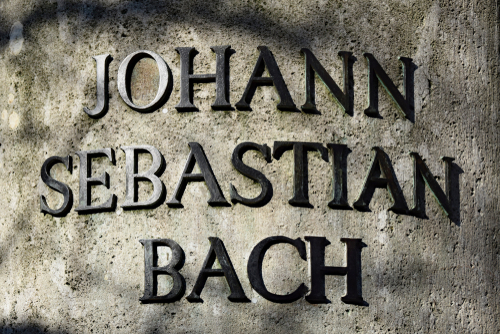
26 Apr The Music of Johann Sebastian Bach
The majority of us would probably agree that sacred music plays an important role in worship. Past listening to a sermon or reading scriptural text, something magical occurs when audio is an essential part of services. It captures emotion which can not be reproduced by text alone, and invites reflection and meditation in a manner that deepens personal faith and devotion to a religious life.
While there are lots of composers that have composed religious music, perhaps none is as highly regarded as Johann Sebastian Bach–who announced that his life work and finish aim was to compose music to the church. He routinely wrote “S.D.G.” (“Soli Deo Gloria”) in the end of his manuscripts, attributing credit and glory to God. He is also well known for stating that “the final goal and reason of all music is nothing other than the glorification of God and the refreshment of the spirit.”
When he died in 1750, the popularity of his songs waned–though surprisingly, he wasn’t really known because of his newfound talent throughout his life. He was admired as an accomplished musician, but not necessarily hailed as a fantastic composer. It wasn’t until Mendelssohn ran a edition of this St. Matthew Passion several 79 years after his departure that interest in his work started to revive.
He was born March 21, 1685, at Eisenach’s village, to Johann Ambrosius Bach and Maria Elisabeth Lämmerhirt. He’d drop them both, within weeks of each other, as a young boy. Bach was a deeply religious man, a staunch Lutheran who staged at the same church choir that Martin Luther had sung in 200 decades before. It was Luther who said that “notes can make the words come alive,” and that appears to be a message Bach took to heart. He was a master at combining religious text with strikingly beautiful harmonies and thought-provoking arias. By so doing, he was able to transfer the listener into scriptural narratives, inviting them to consider the personal consequences of Christ’s life to the thoughtful religious follower.
Bach was the youngest child, and if his parents died, he and his brother went to live with their older brother, Johann Christoph. Christoph was an organist in Ohrdruf, also despite the sorrow and change he was confronting, Sebastian seems to have thrived in college in this new location. By the time he was 15, he secured a singing scholarship in Lüneburg, a space some 230 miles from his brother’s home. He traveled on foot with a friend, and was there for 3 years.
His career began in Arnstadt, and it was here that he had an incident using a bassoonist he had been criticized. Later, that exact same gentleman physically confronted Bach with a stick, to which Bach reportedly reacted by drawing his rapier. It was also here that he requested to leave for four months in order to see Buxtehude, was gone four weeks, and doesn’t seem to have been that apologetic about his lack of thought.
Eventually, he made Arnstadt to take a position in Mühlhausen, and this was the place where he married his cousin, Maria Barbara, as well. After working for a short time there, in Weimar for a while, he took a post in Köthen working with Prince Leopold. Since the prince was a Calvin and also their religious tenets were different, Bach didn’t write a great deal of sacred music reflecting his own beliefs during this time period. Some of the famous works, however–notably the Brandenburg Concertos and the set of famous Cello Suites–were written during his stay here. This was a fantastic time for him personally, though despair was to hit again when his wife died here in the young age of 35.
After he married Anna Magdalena a year and a half later, she had been a singer and a woman many years his junior. Following his marriage, they ultimately ended up in Leipzig, where Bach took a position at the Thomasschule. This was a very busy time for him. Directing the choir boys and having to participate in some of their secular studies also was one thing, but the quantity of songs he was turning around during this time is pretty mind-boggling. He had been writing a complete cantata every week, and after the writing was done, the manuscripts needed to be reproduced so that every musician had the songs for their device’s part. The sheer enormity of that job is simply herculean. It was also during this time that he wrote two of his large works, the St. Matthew Passion and the St. John Passion. The St. John was composed first and played for the first time on Good Friday in 1724 at the Nikolaikirche. Three Decades later, also on Good Friday, the St. Matthew Passion premiered at the Thomaskirche in Leipzig.
Bach remained in Leipzig until his death in 1750. Though he was not initially buried there, his tomb is now in the Thomaskirche (Leipzig), the place where he spent the majority of his career. Today, over 250 years after, his music is considered as some of the finest of all time. His religious music remains employed for worship, as choirs and conductors of different faiths perform a number of his amazing works. His gifts and religious sensibilities have lucky churches, church choirs, and the planet at large.
If your church choir is getting ready for a performance in your community and you’re trying to find out a transportation for a large group, please allow our charter bus rental Maine give a hand! We know that keeping everyone together is important, and also our charter bus rental Maine have ample storage space for instruments too. If it comes to getting a choir from one spot to another, we are the answer you’re looking for. Contact us today!
The information for this post came from the following sources:
https://www.youtube.com/watch?v=5o1DZPqqx-M
https://www.goodreads.com/author/quotes/115200.Johann_Sebastian_Bach


No Comments